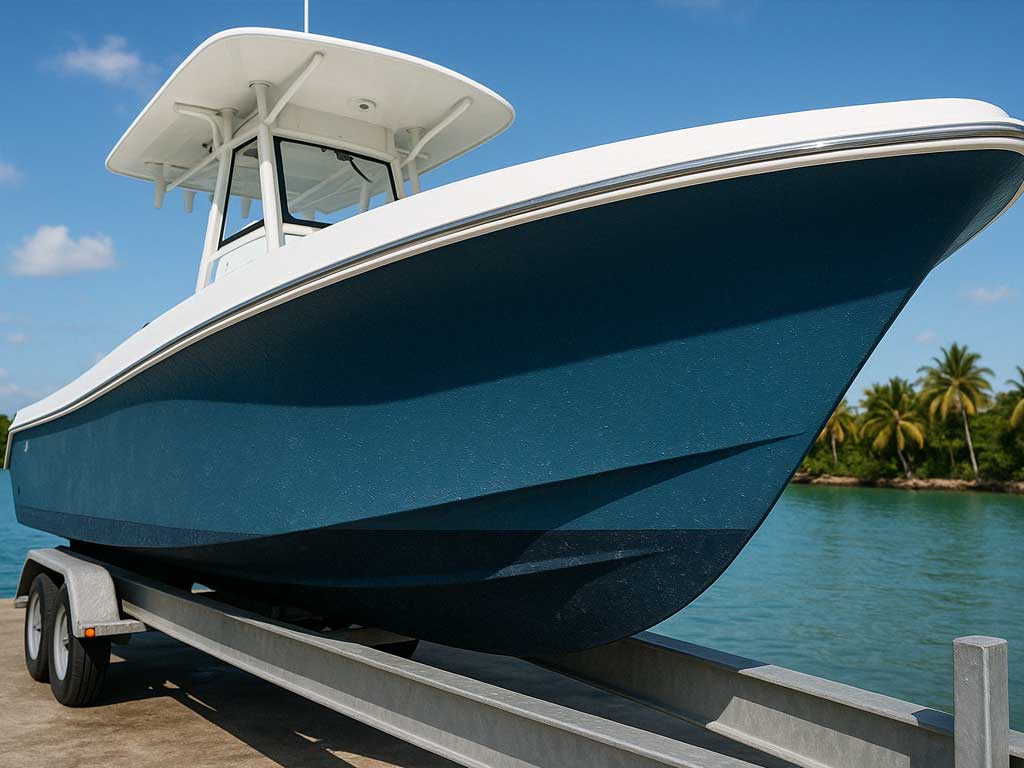Man, we pulled a customer's boat out last summer after just 3 months in Miami's waters and couldn't believe our eyes. The bottom looked like it had been growing an underwater garden! Seriously, the thing was COVERED. If you've been there, you know exactly what we're talking about.
Those gorgeous blue waters we all love for weekend cruising? Yeah, they're basically a perfect breeding ground for every little critter that wants to hitch a ride on your hull. It's the dirty little secret of boating in paradise.
So what about bottom paint? Worth it or just another expense the marina guys try to push on you? We've been servicing boats in Miami for years, and here's our take on whether you actually need this stuff.

What Bottom Paint Actually Does
Bottom paint is kinda like sunscreen for your boat. Except instead of blocking UV rays, it keeps all those clingy sea creatures from setting up shop underneath.
Here's the deal:
- It's got chemicals that make barnacles and algae think twice about attaching
- Creates a slippery surface that makes it harder for stuff to stick
- Helps protect your hull from getting eaten away by saltwater
- Keeps your boat moving faster with less fuel
- Stops your boat from handling like a bathtub full of rocks
We learned this lesson the hard way with many of our customers. One client took his center console out for what should've been a quick run to Elliott Key last August. Boat felt sluggish the whole way. Burned through way more gas than normal. When we finally checked underneath? Looked like he was dragging half the ocean floor with him. Even a thin layer of gunk can cut your speed by 10% and suck up to 30% more fuel. Ouch.
Why Miami Waters Are Extra Tough on Boats
Miami isn't just tough on your wallet and your liver during boat parties - our waters are particularly harsh on hulls.
Here's why:
- Water temps rarely drop below 70°F - basically a 24/7 growth spa
- Super salty conditions that marine growth absolutely loves
- Tons of microscopic plant and animal life floating around
- Sunshine for days that kicks biological activity into overdrive
- We boat year-round, so no winter break from the water
We have clients who keep the same model boats in North Carolina. They can go months without much growth. Down here? Two weeks in August and your waterline already has that gross green mustache thing happening. Our tropical paradise is basically heaven for anything that wants to grow on your hull. It's not fair, but it's reality.
How to Tell If Your Boat is Begging for Bottom Paint
Not sure if you need to bite the bullet?
Watch for these signs:
- That gross green or brown slime creeping up around the waterline
- Hard little barnacle bumps you can feel when washing the boat
- Your boat suddenly feels like it's dragging a parachute
- Filling up way more often for the same trips
- Hull feels rough and sandpapery when you run your hand along it
Next time you're at the dock, reach down and feel just below your waterline. Rough texture? You're already losing performance. We've seen so many Miami boaters shocked when they finally haul out - "I had no idea it was that bad!" Trust us, what's happening below the water is usually worse than you think.
When You Can Probably Skip the Bottom Paint
Look, bottom paint isn't cheap, and not everyone needs it.
You might be fine without if:
- Your boat lives on a trailer or lift when not in use
- You only take it out once in a blue moon
- You're super dedicated about scrubbing the hull after every trip
- You keep it in one of those fancy dry-stack buildings
- You somehow only boat in freshwater (are you even in Miami?)
We have a customer who trailors his flats boat after every single use. Rinses it down, lets it dry completely. He gets away without bottom paint just fine. But let's be real - most boat owners aren't that disciplined. You get busy, the boat stays in the water, and suddenly it's growing more life than a science experiment.
Picking Bottom Paint That Actually Works Here
So you've decided to paint. Now what?
Miami's conditions need specific consideration:
- Ablative paints (the kind that slowly wear away) work great if you use your boat regularly
- Hard paints last longer but are a pain to prep when it's time to reapply
- There are copper-free options if you're worried about the environment
- Aluminum boats need special paint or you'll create a science experiment in galvanic corrosion
- Dark colors hide growth but white/light colors let you spot problems early
For most weekend warriors, a decent ablative paint makes the most sense. These gradually wear away as you use the boat, constantly exposing fresh biocides that keep the critters away. According to the American Coatings Association, about 90% of protected boats worldwide use copper-based coatings, which have been around for at least a century. If your boat sits for weeks between uses (hello, hurricane season), look for modified ablatives that keep working even when the boat isn't moving.
DIY or Hire a Pro?
Thinking about slapping on some bottom paint yourself to save a few bucks?
Here's what you're in for:
- Hours of sanding and prep work (the worst part by far)
- Need for space to work, plus masks, suits and other safety gear
- Dealing with Florida's humidity affecting how the paint dries
- Getting the application technique right so it actually works
- Risking expensive mistakes if you mess up
We've seen many boat owners try the DIY route once. ONCE. They spend an entire weekend sweating through clothes, covered in blue dust, questioning life choices. About 80% of the job is just prepping the surface before you even open the paint can. Many end up with an uneven application that fails early in spots. Next time? They call Boat Repair Miami. Worth every penny for something that actually lasts.
How Long Will It Last in Our Waters?
Once you've got fresh bottom paint, how long before you're doing it all over again?
In Miami:
- Most paints last about a year, maybe 18 months if you're lucky
- Regular hull cleaning makes a HUGE difference in longevity
- Watch for patches where growth starts breaking through
- The waterline usually fails first (sun + water = double trouble)
- After a few years, you might need to strip it all and start fresh
Even top-shelf paint has its limits in our warm, growth-happy waters. We've found that getting a diver to clean the hull every couple months makes a paint job last way longer. It's like $100-150 per cleaning, but extends the $1000+ paint job significantly. Most Miami boaters we know plan to haul out and repaint every other year. Just build it into your boating budget like insurance or dock fees.
The Environmental Stuff
We love our waters, and we bet you do too. So let's talk about keeping them clean while still protecting our boats:
- Traditional copper paints aren't great for marine life
- Newer eco-friendly options actually work pretty well now
- Some fancy marinas have rules about what paints you can use
- Don't be that guy who pressure washes old paint right into the bay
- Regular gentle cleaning means you can use less toxic stuff
The industry has come a long way with environmentally friendlier bottom paints. Research from Practical Sailor shows that a copper leach rate of 9.5 μg/cm² per day is enough to keep growth at bay while minimizing environmental impact. That's the same limit California uses in their regulations. We've switched to lower-copper formulas for many of our customers and honestly haven't noticed any difference in performance. Ask us about eco-friendlier options - they've gotten much better in recent years.
Bottom Line: What's Right for Your Boat?
So do you REALLY need bottom paint in Miami? If your boat stays in the water for more than a couple weeks at a time, we'd say absolutely yes.
Without it, you're looking at performance issues, higher fuel costs, and potentially even damage to your hull over time. Saltwater is brutal on boats - that's just reality. The investment in good bottom paint pays for itself through better fuel efficiency, less cleaning headaches, and better resale value down the road.
Regular cleaning services help a ton whether you paint or not. And if you've already got damage from letting growth go too long, get some fiberglass repair done before applying new paint.
Want to protect your investment from Miami's aggressive marine growth? Our team at Boat Repair Miami deals with this stuff every day. Give us a call at 305-290-2701 or request service online. We'll help keep your boat running smooth and looking great all season long.






.png)